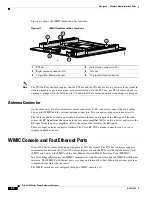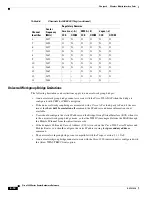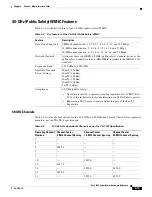
6-3
Cisco 3200 Series Router Hardware Reference
OL-5816-10
Chapter 6 Wireless Mobile Interface Cards
In contrast, the Serial Mobile Interface Card (SMIC) and FESMIC communicate with the router through
the PC/104-
Plus
bus. The interfaces are configured through the router console port, and all of the router
and FESMIC Fast Ethernet ports are identified by using the slot/port format.
The WMIC runs an independent Cisco IOS image and when it is configured, the link between the WMIC
and the router forms an internal LAN. In standard configurations, a WMIC Fast Ethernet port is never
brought out to the end cap.
The WMIC console port is brought out to the corresponding RJ-45 port on the I/O end cap, replacing a
Fast Ethernet port. If the router includes one WMIC, the RS-232 WMIC console port replaces a Fast
Ethernet port on the end cap. If the router includes two WMICs, two WMIC EIA/TIA-232 console ports
replace two Fast Ethernet ports on the end cap.
Note
At present, even if the router contains zero WMICs, in standard configurations a maximum of three Fast
Ethernet ports are brought out to the end cap. Unused EIA/TIA-232 ports are sealed.
Fast Ethernet Signals on the WMIC
The Fast Ethernet signals are delivered through a 10-pin header. LED signals and EIA/TIA-232 console
signals are provided through the 24-pin multifunction header.
There is one set of fixed Fast Ethernet signals on the WMIC. The Fast Ethernet port signals comply with
IEEE 802.3. The signals are provided through the Ethernet headers, which support the following:
•
Autonegotiation for 10/100BASE-TX connection
•
Full-duplex and half-duplex modes
•
Low-power sleep mode
•
10BASE-T and 100BASE-TX using a single Ethernet connection
•
Robust baseline wander correction performance
•
Standard carrier signal multiple access collision detect (CSMA/CD) or full-duplex operation
•
Integrated LED drivers
Note
If Auto-MDIX is disabled, when connecting to Ethernet switches or repeaters, use a straight-through
cable. When connecting to compatible workstations, servers, and routers, use a crossover cable. If
Auto-MDIX is enabled, you can use either a straight-through cable or a crossover cable to make the
connection, as the router automatically changes the signals on the pins to compensate.
















































